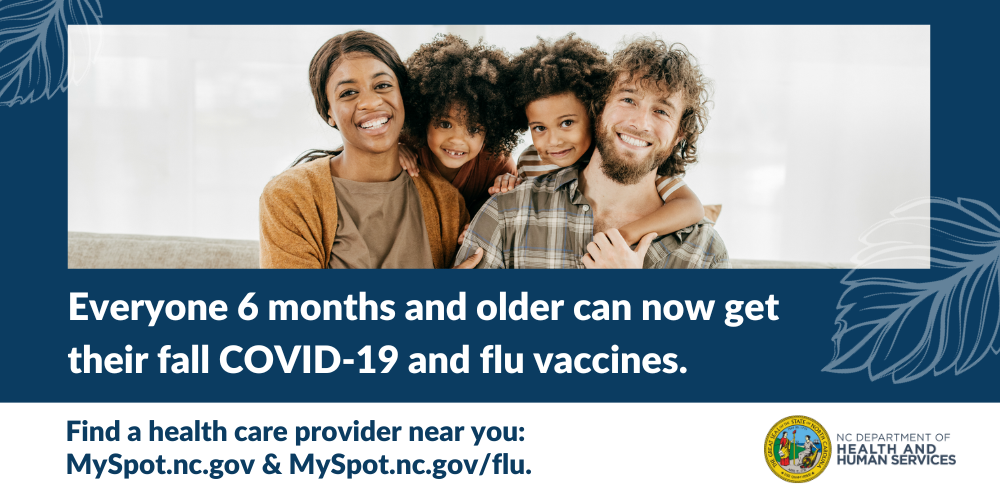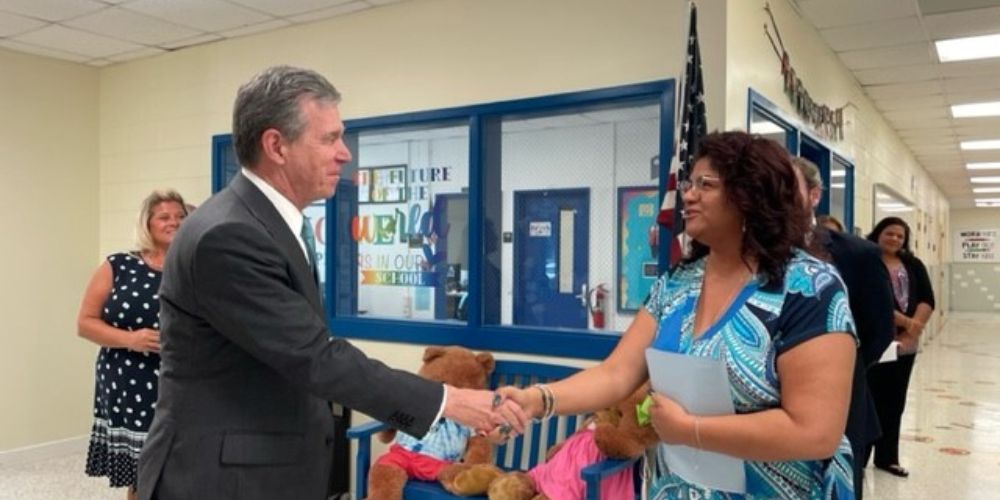|
|
|
|
|
|
 |
Everyone 6 months and older should get the fall COVID-19 vaccine with their flu shot. Because the COVID-19 virus continues to evolve, the updated COVID-19 vaccine is designed to match the changed virus and help protect people from serious illness, hospitalization and death.
The new vaccine becomes available at a time when North Carolina is seeing an increase in COVID-19 infections. Providers began pre-ordering the fall COVID-19 vaccines on Sept. 8, and supplies could begin coming into the state at the end of this week, with more availability starting next week. Talk to your local pharmacy, grocery store, doctor or other provider about scheduling an appointment.
Health officials also recommend everyone 6 months and older get their annual flu shot, ideally before the end of October. This year, for the first time, there is also an RSV vaccine to protect people 60 years and older.
For people with health insurance, most plans will cover the COVID-19 vaccine at no cost. The state will also receive a limited supply of free vaccines for uninsured or underinsured adults through the federal Bridge Access Program. Children who are insured by Medicaid or are uninsured or underinsured can get vaccines at no cost through the Vaccines for Children (VFC) program, which offers vaccines to eligible children through age 18.
For more information about COVID-19 vaccines, visit MySpot.nc.gov, call the CDC-INFO Contact Center at 800-CDC-INFO, or visit ncdhhs.gov/LHD to contact a local health department. Read the CDC’s full statement about recommending the updated COVID-19 vaccine for the fall/winter virus season. |
|
 |
|
Lorena Gonzalez, senior manager for the Early Education Branch in NCDHHS' Division of Child Development and Early Education, meets Gov. Cooper for a tour of Mary Washington Howe Pre-K Center in Wilmington
Gov. Cooper is directing $8 million in federal funding to provide a one-time special allocation to all NC Pre-K classrooms to help address classroom needs for the new school year. The NC Pre-K Program operates in every county statewide to provide high-quality early childhood education for eligible children.
This one-time special allocation can be used for upgrading classroom materials, toys, supplies, playground equipment, supplemental curriculum materials, ongoing facility maintenance needs, mental health support for children and staff, professional development for staff, and other needs. NCDHHS will distribute the funding to provide approximately $3,860 per classroom for the 2,098 NC Pre-K-funded classrooms statewide that are serving students this year.
Funding for this new investment in NC Pre-K is from federal Emergency Assistance for Non-Public Schools (EANS) funds that have reverted to the Governor’s Emergency Education Relief (GEER) fund. |
|
|
|
 |
NC Pandemic Response Shows Investment in Early Learning Works
A new report showcases how North Carolina supported and invested in its child care programs so they could remain open during the COVID-19 pandemic, preserving the state’s early childhood education infrastructure and setting it apart from other states. North Carolina's approach focused on prioritizing the workforce, offsetting increasing operational costs, supporting all licensed child care programs and recognizing rural costs. North Carolina’s approach to using one-time federal stabilization funding allowed its child care system to fare better than most states. While the nation lost on average 8% of its child care workforce, North Carolina is down less than 1%. Many child care programs report that without continued stabilization funding they will close programs, reduce the number of children served and/or increase parent fees. With federal funding to stabilize the child care industry ending this year, continued funding is needed. To learn more, visit RaiseNC.nc.gov, and download the report. |
|
 |
Highlighting Resources for Those in Need
Suicide is a statewide and national public health crisis impacting people of all ages across all socioeconomic, racial and ethnic backgrounds. Suicide awareness is key to saving lives, and with September recognized as Suicide Prevention Awareness Month, NCDHHS remembers those affected by suicide and is raising awareness of treatments and resources available to everyone in the community. In 2022, 1,539 North Carolinians ages 10 and older died by suicide, making it the ninth-leading cause of death in the state and the second-leading cause of death for people between the ages of 10 to 40. NCDHHS has been leading the work on one of the state’s largest resources for suicide prevention: 988. This three-digit suicide and crisis lifeline connects people via call, chat or text to a trained counselor who will listen, offer support and provide community resources 24 hours a day, 7 days a week. Call or text 988, or chat at 988lifeline.org. People who speak Spanish can now connect directly to Spanish-speaking crisis counselors by calling 988 and pressing option 2, texting “AYUDA” to 988, or chatting online at 988lineadevida.org or 988Lifeline.org. |
|
 |
How to Manage Recovery in College
In honor of Collegiate Recovery Programs (CRPs), NCDHHS' Division of Mental Health, Developmental Disabilities, and Substance Use Services will host a webinar to address the growing need for behavioral health care among young adults, and the beneficial impact of CPRs for college students in recovery from substance use disorders on Sept. 21 from 1 to 2 pm. CRPs have been in existence for more than 40 years. They were developed in response to the growth in drug and alcohol use among adolescents and young adults, the risks posed to students while on campus and the unique needs of students in recovery. CRPs provide services and educational opportunities in a supportive environment, as well as promote personal accountability while attending a public or private college or university. Register for the event and see a flyer for more information. |
|
|
|
 |
Program Launched to Eliminate Exposure to Lead and Asbestos
NCDHHS, in partnership with the NC Department of Public Instruction (NCDPI) and RTI International, announced that the Clean Classrooms for Carolina Kids™ program is ready to help public schools, licensed child care centers and family child care homes identify and eliminate exposure to lead and asbestos hazards in building infrastructure. The program is an expansion of Clean Water for Carolina Kids™, which previously tested all child care centers in the state for lead in water at drinking and food preparation taps. Lead and asbestos are known health hazards with no safe level of exposure. Public school facilities will be contacted by the NCDPI, while licensed child care centers and family child care homes will be contacted by NCDHHS' Division of Child Development and Early Education when it is time to enroll, beginning this month. In total, $150 million of American Rescue Plan Act funding was allocated by Gov. Cooper and approved in the legislative budget. The program funding will be available until Nov. 30, 2026. |
|
 |
Four Steps for Food Safety
September is National Food Safety Education Month and NCDHHS is raising awareness about common foodborne illnesses and steps you can take to prevent them. According to the CDC, there are approximately 48 million cases of foodborne illness each year across the U.S., affecting one in six Americans. Common foodborne pathogens include Salmonella, Escherichia coli (E. coli), Norovirus and Listeria, and symptoms of food poisoning may include diarrhea, stomach pain or cramps, nausea, vomiting and/or fever. NCDHHS recommends four steps you can take to prevent foodborne illness. 1) Clean. Always wash your hands for 20 seconds with soap and warm water and wash utensils, cutting boards and countertops. 2) Separate. It is important to prevent cross-contamination whenever you are handling different food items. 3) Cook. Cooking all foods to the proper temperature is an important step in preventing foodborne illness. 4) Chill. It is important to refrigerate and store leftovers promptly and avoid leaving food sitting out whenever possible. Learn more about foodborne illness at NCDHHS' Division of Public Health or on the CDC's website.
|
|
|
|
|
|
|
|

